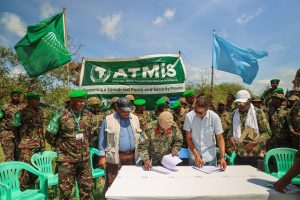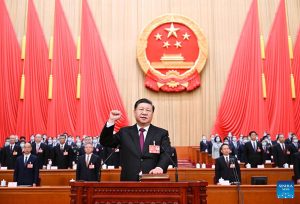Uganda forces in fierce battles with al-Shabaab

Expert say without AU force, Somali army should prepare to face hundreds of additional attacks
COVER STORY | THE INDEPENDENT | The al-shabaab militia is launching more attacks on Ugandan forces than at any other African Union forces of the Transition Mission in Somalia (ATMIS).
That is according to a report by the international non-profit organisation, Armed Conflict Location and Event Data (ACLED) which gathers data on the conflict.
In about one month, between April 20 and May 24, ACLED says al-Shabaab made 98 attacks on Somali security forces and ATMIS forces. Most of the attacks, up to 50 of them, were on the Ugandan forces in Lower Shabelle where they operate ATMIS bases and logistics convoys, and operate airport security.
In total, over this period ACLED recorded more than 207 political violence events and 432 reported fatalities. Most political violence centered in the Lower Shabelle region, where al-Shabaab increased attacks targeting security forces. The most common event type was battles, with over 119 events, followed by explosions/remote violence, with 55 events.
ACLED says the increased attacks are part of the al-Shabaab’s strategy to expand their control over strategic areas and routes in anticipation of a power vacuum when ATMIS exits Somalia as expected by the end of December 2024, according to the United Nations Security Council Resolution 2710 (2023).
By end of May al-Shabaab had positioned along the main routes connecting the two regions of Lower Shabelle and Banadir where most attacks on ATMIS occurred. They continue operations along the Mogadishu-Balcad main supply routes and have also been regrouping and planning attacks against security forces in the border areas in Galgaduud and Ceel Dheer districts.
The al-Shabaab have also exploited the inability of the Somali National Army (SNA) to maintain coordination of the holding forces in areas they capture. ACLED said on 26 April, al-Shabaab took control over three villages in the Jowhar district, followed by the arrival of around 200 militants in Cali Fool Dheere village to set up hideout positions.
Throughout phases of the counter-insurgency operations against al-Shabaab, special forces like Danab and Gorgor — trained by the US and Turkey, respectively – and clan militias have been used as holding forces at government-controlled bases, while the SNA advanced towards the more remote al-Shabaab-controlled areas.
But long-standing coordination issues between the SNA command center and the Ministry of Defence continue to hamper the ability of the security forces to hold the territory seized from al-Shabaab.
Also when on May 14, U.S. forces and the SNA conducted two joint airstrikes against al-Shabaab positions in Cali Xayle and Baraag Sheekh Caamir villages, killing at least nine militants, the al-Shabaab assaulted SNA/ATMIS forward operating bases situated near Xawaadleey village in Middle Shabelle.
Big loss looms
These renewed attacks pose one major question, according to experts: Will the Somali National Army (SNA) remain stronger militarily without the ATMIS forces or Mogadishu will be easily overrun by al-Shabaab?
The experts say the ATMIS is leaving because the Federal Government of Somalia (FGS) is confident it no longer needs the mission. But it’s also, in part, because external partners have baulked at the cost of financing it.
But many worry that if al-Shabaab emerges stronger militarily than the national army, it will be a major loss for Uganda and other troop contributing states which has invested heavily in stabilising Somalia in the last 17 years. ATMIS consists of troops from Burundi, Djibouti, Ethiopia, Kenya, and Uganda.
Ugandan and other forces might of course not leave Somalia this December because the AU is putting together a post-ATMIS force to help protect strategic population centres, UN facilities and key government installations. This has been a major role of the Ugandan forces under ATMIS.
And the Ugandan forces together with the Somali Army (SNA), with the support of international partners, have also intensified attacks on al-Shabaab hideouts over the same period. These could weaken al-Shabaab more.
Over this period, for example, the Somali government has also announced plans for another round of counter-insurgency operations to eradicate al-Shabaab from central and southern Somalia, where they hold large swaths of territory.
According to ACLED, however, this operation continues to grapple with long-standing issues that have hampered the effectiveness of counter-insurgency, including inter-clan disputes and corruption in public procurement.
The Somali government is losing the support and backing of clan elders and militias, some of which have either entered into non-aggression pacts or decided to support al-Shabaab. Since June 2023, infighting among clans and animosity towards the federal government have weakened the coalition supporting the counter-insurgency.
The clan disputes are over power-sharing arrangements and access to land and some have led to armed clashes between the clan militias. According ACLED this reflects the fragile order reigning in the coalition. In some cases they have led to clan militias fighting alongside government troops vacating security bases, causing the offensive to slow down and al-Shabaab to regain lost territories.
ACLED says, in May the government attempted to revive clan support for a third round of the counter-insurgency operation. On 11 May, some members of the Somali parliament and the director of the Somali National Security and Intelligence Agency met with residents and traditional elders to discuss the Hawadle clan’s participation in the fight against al-Shabaab.
Corruption involving senior military officials is also a major challenge. The military officials mainly divert the food rations donated by the United States for commercial uses. On 25 April, the government suspended and detained several members of the American trained elite special operations force, Danab or `Lightning Force’ in connection with a corruption scandal. This action was taken days after the U.S. announced the suspension of food rations to Danab forces due to corruption.
The Danab forces, specifically, are trained and equipped by the U.S. for increased counterterrorism capabilities, raiding al-Shabaab, and recapturing territory. But the fallout of the corruption scandal led to the withdrawal of security forces from several strategic villages and their subsequent recapture by al-Shabaab.
Troop reduction
The African Union (AU) has gradually reduced its troop numbers in Somalia since late 2017, from a peak of over 22,000 to about 14,000 today. Another 4,000 AU peacekeepers are scheduled to withdraw by the end of September and the entire AU Transition Mission in Somalia is scheduled to leave by 31 December 2024.
African Union peacekeepers were first deployed to Mogadishu in March 2007. Their mandate was to protect the then Transitional Federal Government and support dialogue and reconciliation in Somalia.
Since then, the AU mission has played a vital role in the fight against the Islamist militant group, al-Shabaab. They pushed al-Shabaab forces out of Mogadishu in 2011, recovered dozens of settlements across south-central Somalia between 2012 and 2014, and helped to establish and secure four new federal member states in Somalia between 2013 and 2017. Nevertheless, al-Shabaab was not defeated and remains one of Africa’s most deadly insurgencies.
The AU transition mission is leaving because the federal government of Somalia is confident it no longer needs the mission. But it’s also, in part, because external partners have baulked at the cost of financing it.
Without the AU there, would the Somali National Army or al-Shabaab be stronger militarily? This was the question posed in an assessment of the two forces by Paul D. Williams, Professor of International Affairs, George Washington University.
His work, entitled `The Somali National Army Versus al-Shabaab: A Net Assessment’ was published in the April 2024, Volume 17, Issue 4 of the CTC Sentinel; a journal by the Combating Terrorism Centre (CTC) at West Point USA.
Prof. Williams has researched the effectiveness of peace operations and the dynamics of warfare in Africa for more than two decades and published numerous articles and books, including `Fighting for Peace in Somalia – a history and analysis of the African Union Mission in Somalia’.
An abstract to the work states: An important question for the future of Somalia is if the African Union withdraws the remainder of its forces from the country by December 31, 2024, would the Somali National Army (SNA) or al-Shabaab be stronger militarily? According to a net assessment conducted by the author across seven factors—size, material resources, external support, force employment, cohesion, psychological operations, and morale—the SNA would retain an advantage in terms of size, material resources, and external support but performs poorly on non-material dimensions and would remain dependent upon external finance and security assistance. Overall, however, al-Shabaab would be slightly militarily stronger because of its significant advantages across the non-material dimensions related to force employment, cohesion, and psychological operations, as well as the sustainability of its forces.
In a related article in the online journal, The Conversation, Prof.Williams summarises that longer study based on the seven factors.
Comparing the Somali army and al-Shabaab
• Size: At around 20,000 troops, the Somali army is probably already over twice the size of al-Shabaab. If its current recruiting plan succeeds, it will be well over three times as large. However, measuring each side’s mobile forces – the number of troops with vehicles able to conduct operations over large distances – reveals much greater parity. Moreover, while al-Shabaab’s true strength remains unknown, the militants have consistently replenished their losses through forcible recruitment and attracting new supporters.
Assessment: Somali army advantage, but rough parity of mobile forces.
• Material resources: Al-Shabaab has a much leaner and less technically sophisticated fighting force than the Somali army. It is therefore cheaper to maintain. The militants also maintain diverse revenue streams. The army has the technological edge, but its greater numbers, administrative and support elements require more funding, currently more than the federal government can afford alone. It is an open question how long Somalia’s external partners will continue to pay for assistance for the army.
Assessment: The army has a financial advantage in absolute terms, but is dependent on external partners. Al-Shabaab advantage in terms of sustainability. Army has a slight and growing technical advantage.
• External support: Even without the African Transition Mission in Somalia, the Somali army would likely retain considerable security assistance from about ten external partners. But it can also create unhelpful dependencies, fragment the force, and generate coordination and capacity challenges. Al-Shabaab receives only limited funding and technical expertise from al-Qaeda.
Assessment: Army advantage, but al-Shabaab has few external dependencies.
Force employment: Al-Shabaab is waging a war of destabilisation using guerrilla tactics, which are cheap and effective. The army, in contrast, is spread over many operating bases and trying to control territory, urban settlements and supply routes. An African Mission withdrawal would take pressure off al-Shabaab, enabling them to focus more attacks on the army.
Assessment: Al-Shabaab advantage.
• Cohesion: The army remains fragmented for two principal reasons. First, Somalia’s bickering political leaders have failed to clarify force structures and the relationship between the federal government and the country’s federal member states. Second, the army has been built by multiple security partners who have used different doctrines, techniques and equipment. Al-Shabaab’s fighting force is more cohesive, despite some clan-related tensions.
Assessment: Al-Shabaab advantage.
• Psychological operations: Al-Shabaab continues to send out its strategic messages about endurance, inevitability and invincibility. Those themes resonate with a variety of local audiences in Somalia. The federal government has been reactive and fixated on casualty counts and “recovered” territory while struggling to undermine al-Shabaab’s legitimacy and its strategic narratives.
Assessment: Al-Shabaab advantage.
• Morale: Overall, al-Shabaab’s leadership and much of the rank-and-file appear to have maintained consistently higher levels of confidence than most of the army. Al-Shabaab’s superior morale stems from the belief that they can withstand army offensives and exploit army weaknesses. In comparison, the army’s morale has deflated after the initial progress made during the 2022 offensive. Moreover, the recent positive news about lifting the UN arms embargo, increasing funds and fresh recruits is largely offset by concerns that its international partners may grow weary.
Assessment: Slight al-Shabaab advantage.
Implications of the study
Prof. Williams says his analysis has implications for how to tilt the military balance in Somalia in the federal government’s favour.
First, even without an AU force, the policy challenge for Somalia’s remaining external partners remains the same: how to provide assistance without creating military dependency.
Second, although the army’s material advantages over al-Shabaab are important, they have depended on external support that is no longer guaranteed. After the AU Transition Mission, the army will become even more reliant on its other external partners, especially the United States, Turkey, the UAE and Qatar. Those partners must coordinate and align their political agendas for Somalia.
Third, given the importance of non-material factors in the Taliban’s victory in Afghanistan, this assessment should serve as a warning that reforms are needed. The federal government of Somalia should focus on improving the central non-material issues. It is also risky to put too much emphasis on what can be achieved by rapidly trained new recruits.
Finally, without the AU Transition Mission, the Somali army should prepare to face several hundred additional attacks each year. Most of these attacks would have previously targeted AU forces. Since al-Shabaab’s weapon of choice remains improvised explosive devices, the army should prioritise improving capabilities against this threat.
The post Uganda forces in fierce battles with al-Shabaab appeared first on The Independent Uganda:.






